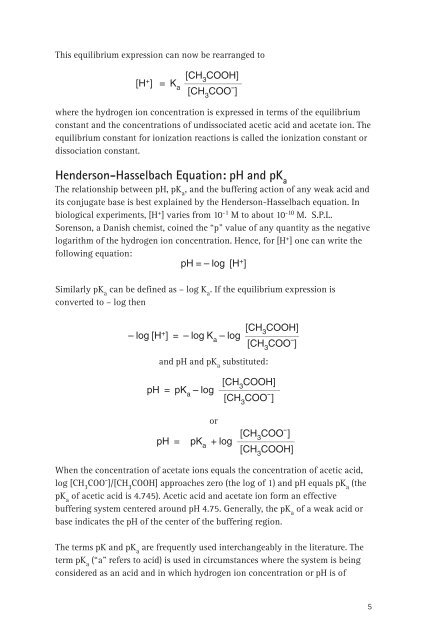A guide for the preparation and use of buffers in biological systems
A guide for the preparation and use of buffers in biological systems
A guide for the preparation and use of buffers in biological systems
You also want an ePaper? Increase the reach of your titles
YUMPU automatically turns print PDFs into web optimized ePapers that Google loves.
This equilibrium expression can now be rearranged to<br />
[CH 3<br />
COOH]<br />
[H + ] = K a<br />
_______________<br />
[CH 3<br />
COO¯]<br />
where <strong>the</strong> hydrogen ion concentration is expressed <strong>in</strong> terms <strong>of</strong> <strong>the</strong> equilibrium<br />
constant <strong>and</strong> <strong>the</strong> concentrations <strong>of</strong> undissociated acetic acid <strong>and</strong> acetate ion. The<br />
equilibrium constant <strong>for</strong> ionization reactions is called <strong>the</strong> ionization constant or<br />
dissociation constant.<br />
Henderson-Hasselbach Equation: pH <strong>and</strong> pK a<br />
The relationship between pH, pK a<br />
, <strong>and</strong> <strong>the</strong> buffer<strong>in</strong>g action <strong>of</strong> any weak acid <strong>and</strong><br />
its conjugate base is best expla<strong>in</strong>ed by <strong>the</strong> Henderson-Hasselbach equation. In<br />
<strong>biological</strong> experiments, [H + ] varies from 10 -1 M to about 10 -10 M. S.P.L.<br />
Sorenson, a Danish chemist, co<strong>in</strong>ed <strong>the</strong> “p” value <strong>of</strong> any quantity as <strong>the</strong> negative<br />
logarithm <strong>of</strong> <strong>the</strong> hydrogen ion concentration. Hence, <strong>for</strong> [H + ] one can write <strong>the</strong><br />
follow<strong>in</strong>g equation:<br />
pH = – log [H + ]<br />
Similarly pK a<br />
can be def<strong>in</strong>ed as – log K a<br />
. If <strong>the</strong> equilibrium expression is<br />
converted to – log <strong>the</strong>n<br />
[CH 3<br />
COOH]<br />
– log [H + ] = – log K a<br />
– log ______________<br />
[CH 3<br />
COO¯]<br />
<strong>and</strong> pH <strong>and</strong> pK a<br />
substituted:<br />
[CH 3<br />
COOH]<br />
pH = pK a<br />
– log ________________<br />
[CH 3<br />
COO¯]<br />
pH =<br />
or<br />
[CH 3<br />
COO¯]<br />
pK a<br />
+ log _______________<br />
[CH 3<br />
COOH]<br />
When <strong>the</strong> concentration <strong>of</strong> acetate ions equals <strong>the</strong> concentration <strong>of</strong> acetic acid,<br />
log [CH 3<br />
COO¯]/[CH 3<br />
COOH] approaches zero (<strong>the</strong> log <strong>of</strong> 1) <strong>and</strong> pH equals pK a<br />
(<strong>the</strong><br />
pK a<br />
<strong>of</strong> acetic acid is 4.745). Acetic acid <strong>and</strong> acetate ion <strong>for</strong>m an effective<br />
buffer<strong>in</strong>g system centered around pH 4.75. Generally, <strong>the</strong> pK a<br />
<strong>of</strong> a weak acid or<br />
base <strong>in</strong>dicates <strong>the</strong> pH <strong>of</strong> <strong>the</strong> center <strong>of</strong> <strong>the</strong> buffer<strong>in</strong>g region.<br />
The terms pK <strong>and</strong> pK a<br />
are frequently <strong>use</strong>d <strong>in</strong>terchangeably <strong>in</strong> <strong>the</strong> literature. The<br />
term pK a<br />
(“a” refers to acid) is <strong>use</strong>d <strong>in</strong> circumstances where <strong>the</strong> system is be<strong>in</strong>g<br />
considered as an acid <strong>and</strong> <strong>in</strong> which hydrogen ion concentration or pH is <strong>of</strong><br />
5
















